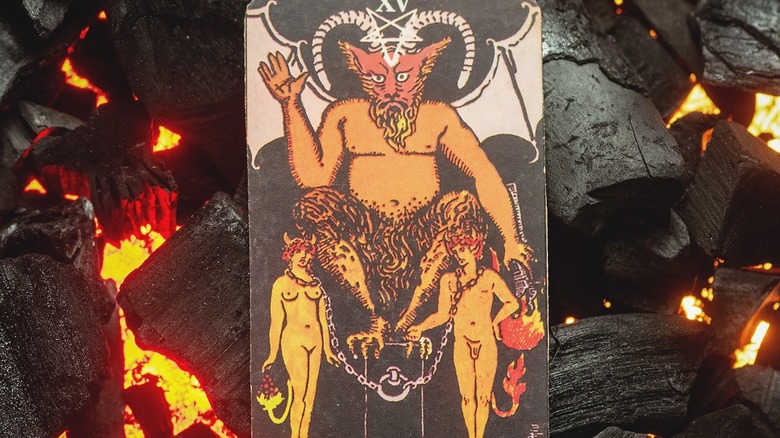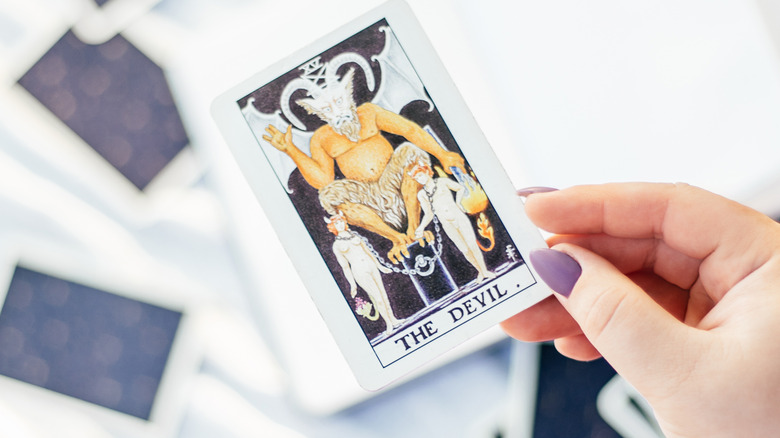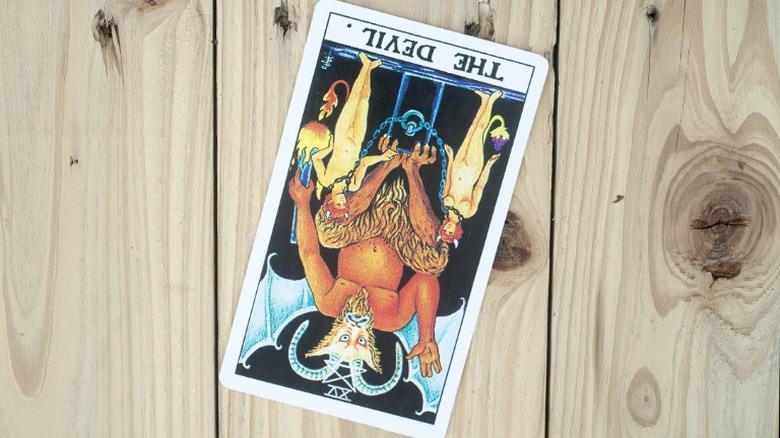What Does The Devil Card Mean In Tarot? (It's Not As Bad As You Think)
Out of the 78 cards in a traditional tarot deck, some — like the Fool or the Star — seem to give off good vibes from the moment you turn them over. Meanwhile, others can seem decidedly sinister. The dramatic energy of cards like Death, the Tower, or the Ten of Swords might immediately put you on edge if they show up in a reading. But one of the cards most dreaded by tarot newbies is probably the Devil.
Many decks base their iconography on the classic Rider-Waite tarot. In this design, the Devil card portrays a devil with ram horns and bat wings, sitting on a pedestal above a naked man and woman in chains. So it's no wonder that people get spooked by this card — after all, what could be more ominous than the appearance of a literal demon?
However, the meanings behind each tarot card are rarely as black-and-white as their images might suggest. Seemingly cheerful cards might carry cautionary warnings, and menacing cards might actually be harbingers of change rather than disaster. That's why it's important that new tarot readers never take their cards at face value, but learn to feel the nuances behind a card's imagery and placement in a spread.
As for the Devil, even this most foreboding of cards can herald important and useful connotations. When you prepare for a tarot card reading — whether you're doing it yourself, or visiting a professional — it's important that you enter with an open mind. Cards can be misleading if you interpret them without the requisite knowledge, so instead of recoiling when the Devil appears, take some time to receive its intended message and put this card to good use in your life. To help you get started, here's what the Devil card actually means in tarot.
When the Devil is upright
To say that a tarot card is upright simply indicates that its image is right-side-up to the card reader when you uncover it in a spread. When this happens, you can take the card at face value and interpret it by its main meaning. For the Devil card, you might think this would be something downright evil, but that's not necessarily the case. Rather, the Devil card invites us to consider and address our dark sides and flaws.
The Devil card is associated with themes like dependency, secrecy, addiction, depression, materialism, temptation, and sexuality — in other words, a whole host of human foibles. When it appears in a reading, the Devil shines a spotlight on these challenges and how they may be holding you back. Here, the significance of the Devil's iconography is particularly important. Just as Satan has been known in Christianity as "The Great Deceiver," the obstacles represented by the Devil card are illusions put in place by our own psyche. Our fears and uncertainties convince us that life is beyond our control, but the Devil card essentially puts us on blast for behaviors that block our advancement.
Instead of fearing the Devil card, take it as an opportunity for self-improvement. In the context of your reading's question or theme, how are you getting in your own way? This card may suggest counterproductive tendencies like impulsive decision-making, negative thought patterns or self-talk, or choosing instant gratification over long-term reward. It can also point out harmful relationships, whether with toxic people or addictions. While this card probably indicates that you're feeling trapped in certain patterns or situations, use the Devil's appearance in a reading to recognize that you have the power to change these habits and remove obstacles toward becoming your best self.
When the Devil is reversed
When we refer to a card as being in reverse, this simply means that the image is upside-down from the tarot reader's point of view. But reversals are a point of some contention in the tarot community. Many practitioners of tarot believe that these upside-down cards carry a slightly different nuance that juxtaposes the regular, upright meaning of the card. However, other tarot readers choose to ignore reversals and read each card for its inherent message, suggesting that the deck's 78 cards already encompass a full range of meanings without getting reversals involved.
That said, if you do choose to include reversals in your tarot readings, you'll need to learn how they alter the implication of any card you turn over — including the Devil. Whereas the upright Devil card suggests restriction and entrapment in a web of negative behaviors or relationships, the reversed Devil card could indicate that you are on the verge of upsetting these patterns — whether you're ready or not. This sweeping change may be painful or difficult, but it's necessary to finally move you away from the limitations represented by the Devil card.
In a sense, the upright Devil points out blockages and the reversed Devil highlights opportunities. So if you're prepared to take action and embrace change, you can use either reading to your advantage. When the Devil card sends up a red flag in your tarot spread, it's time to break free of bad habits, take more accountability for your actions, and reap a sense of empowerment to take control of your own fate.


